As told in ancient legends, Indiana Jones and the Last Crusade was an apology for the misfire that was Temple of Doom, and, as such, rekindled the Raiders flame in a film that captured the same feel and tone as the original, sending audiences cheering into the streets, flinging rubber snakes about, rolling mighty boulders, and erecting golden statues of Steven Spielberg in their wake.
As seen today, Last Crusade is a dull, lifeless slog that tries, and tries, and tries to look and feel like Raiders, but that comes off as a cartoon even less plausible than Temple of Doom.
Remember all the witty quips between Indy and Satipo in Raiders‘ opening? And Indy and his sidekick cracking wise during the truck chase? And Indy and Marion’s hilarious lover’s spat that plays out during the airplane fight? Funny stuff! No wonder Willie shows up in Temple to continue the verbal jousting and wacky romantic hijinks. It worked so well that in Last Crusade we get another jolly sidekick in Indy’s grumpy dad—what is it with this mean old fuddy duddy, am I right?—and the nonstop witticisms continue, thus ensuring we don’t nod off during all the boring chase sequences.
Or so I have to imagine Spielberg thinking. How, one wonders, having made the mistake of re-watching Last Crusade for what must be the first time in 30 years, did Spielberg come to the conclusion that Raiders is a nutty cartoon, that Indy is a lascivious dope, and that what we love about it most is the jokey dialogue? What movie did Spielberg direct way back in ’81? Has he watched it since?
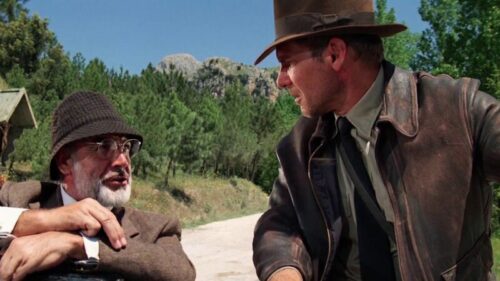
It’s hard to even catalogue everything awful about Last Crusade. I just watched it, and I can’t remember what happens, in what order it happens, and why, at any given moment, I’m supposed to care. In this movie, Indy is not only the worst achaeologist in the world—so bad that the script has Sean Connery tell him more than once that “this isn’t archaeology”—he’s also the dumbest. His plan to save his dad is to smash loudly into his alarmed room in a remote castle packed with Nazis, and then—what? Go where? How? And that’s only in hour seven. By hour fifteen, he’s been miraculously transported from a crashed airplane site somewhere in Germany to the Middle East. Before that he lusts after a German lady within two seconds of laying eyes on her, setting up the great moment in hour twenty-three when we learn that his dad screwed her first. Ha ha! Ha. ha? And it ends with the whole gang trashing some poor bastard knight’s home of 700 years and dumping his Holy Grail into a crevasse.
I feel like the opening played well back in the day. Indy’s young! And oh hey, now we know, 1) Why he’s afraid of snakes, 2) Who he stole his wardrobe from, 3) Where he got the whip idea, 4) How he got the scar on his chin, and 5) Why he’s spent his entire life desperate to capture the man in the white suit!
Wait, who? Nevermind, he’s blown up in the first five minutes. Did this play well in ’89? I don’t know, but today it just feels like everyone’s exhausted and can’t think of anything better to do. Temple of Doom‘s opening is… is… is Raiders compared to this.
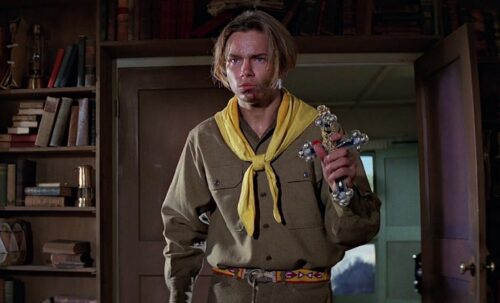
Next up, a professor scene purposefully identical to the one in Raiders, because that’s the scene we love most about the original. Suddenly Indy meets some weird guy for a whole lot of Holy Grail exposition, bam! we’re off to Italy, where Indy, world’s greatest archaeologist, smashes the tiled floor of an ancient church, busts up ancient human remains to make a torch, and dumps the skeletal corpse of a mythical knight into the drink. Whew. What’s next? Wiping his ass with the Shroud of Turin?
Side note: Am I going to hell for writing that last sentence? Hm.
Reading up on how this movie was created one wants to weep. Script after script, writer after writer, every idea loonier than the last. They should have stuck with the Monkey King. What, exactly, were Spielberg and Lucas’s instructions to these writers? “Think Raiders, but like an insane, dumb cartoon with as much god as you can cram in there next to its (Raiders‘) rotting corpse. Which then have Indy break all its bones just for the fuck of it.”
What’s got me mystified, though, is why anyone thought this was a continuation of Raiders? Even Temple of Doom‘s Indy, with his slight and muddled change in character, still feels like Indy. The guy in Last Crusade feels like a scan of a Xerox of a carbon copy of a pencil sketch of the original. With gags. Gags—and Hitler! Just what we needed, a cartoon Hitler. At least the Nazis in Raiders were presented with a modicum of movie-reality. Here they’re just for laughs.
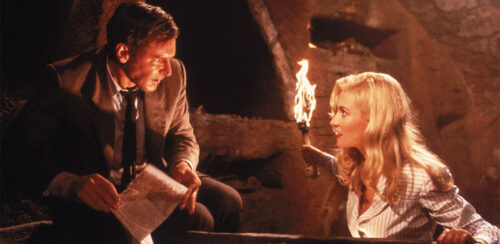
Raiders, as I noted recently, is Spielberg’s funniest movie. Maybe this is why he came away from its success seeing it as a comedy stuffed with dopey gags? Credit Raiders scribe Lawrence Kasdan with humor that isn’t jokey, one supposes.
Last Crusade‘s final (and lone credited) writer, Jeffrey Boam, is the one who came up with the crux of the movie being Indy and his dad’s relationship. They lose the Grail, but find each other. His theory being that in the first two movies, the magical object is obtained, so they needed to go in a different direction. This is problematic for numerous reasons. The first is that in Raiders, they don’t get the Ark. The Nazis do, they open it, die, and next we know, the U.S. government has squirreled it away for good.
Second, there is, one would think, an obvious problem with an adventure/quest movie wherein the sought object has no real purpose. Hitler wants the Grail? Well… okay. We can still poke him with a sharp stick, can’t we? Or cut him up into bits? Even if he’d otherwise never age? “Indy’s dad is really into the Grail” is the reason we, the audience, are given to care about this quest. But why should we care about Indy’s dad? No reason is provided. Using enslaved children is a cheap trick in Temple of Doom, but it’s a cheap trick because, yes, we do want to see the enslaved children freed.
Third, grafting some kind of father/son relationship movie onto a non-stop action/adventure is absurd. There’s no time for it. Also—who cares? Boam’s argument was that we didn’t get enough character development in the first two films. Hm, sounds reasonable, only… Wait. Is the reason everyone hates Goldfinger, the third Bond movie, that, once again, he’s off on some crazy spy adventure without any info about his relationship with his mother? It is not! We love Goldfinger. We don’t care about Bond’s childhood (or so we thought, until, in its most recent incarnation, we were told, loudly, that we should).
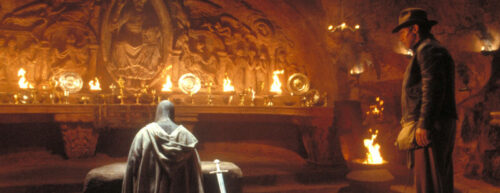
If one had nothing better to do, one could make a thematic argument for Indy’s dad and the Grail and the ending. Hey, in Raiders he didn’t blow up the Ark when he had the chance, and here he lets the Grail go instead of… falling to his death? Hm, he already saved his dad… Well anyway, the point being, we could get all lofty and insist this is a film about a man obsessed with trinkets (he spent his whole life in search of the whatsit from the opening!) at last learning to appreciate a human being, his estranged father. Problem is, this is a non-stop adventure flick. Theme aside, that’s what we’re watching. If the story is uninvolving, and my god is it ever, the theme doesn’t matter. You end up with what I call a “term paper movie.” Yes, you can write a term paper on it (please don’t), but the act of sitting through it is torture.
What I’m getting at is that, somewhere along the way—somewhere very early along the way—whatever it was that inspired Raiders, and whatever Raiders is—was forgotten. Or lost. Or jettisoned. Something was corrupted. Maybe it was the fault of the ’80s, of the way movies changed over that decade, or the way Spielberg and Lucas changed, maybe their cynicism overwhelmed any real creative urges, their need to please the audience, to make the biggest hit, to prove that they knew the secret to blockbuster status and had to prove it once again. Spielberg had had a monetary hit with Temple of Doom, but it was seen as a creative failure. After that came The Color Purple and Empire of the Sun, two early—and failed—attempts to win Oscars and the praise of critics. He hadn’t really been beloved since E.T.. It’s not surprising he felt it was time to go backwards, to resurrect an earlier style.
The resurrection feels like a resurrection. Last Crusade is a zombie movie. They unearthed Raiders, zapped its corpse with cattle prods, and forced it to lumber around a bit, feeding it one-liners in the hopes of distracting us from the stench. The best part is the end, when they ride off into the sunset. Because no matter how sad the preceding movie is, we know this series is done. They wouldn’t dare make another one.
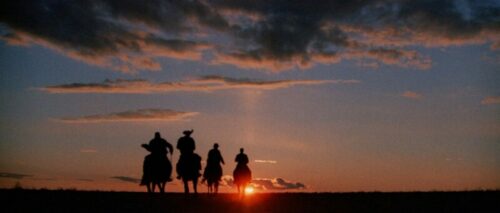

I can’t wait for your Crystal Skull review. Say hi to Mutt for me.
Oh, it’s coming. I’m all in. May the aliens have mercy on my soul.